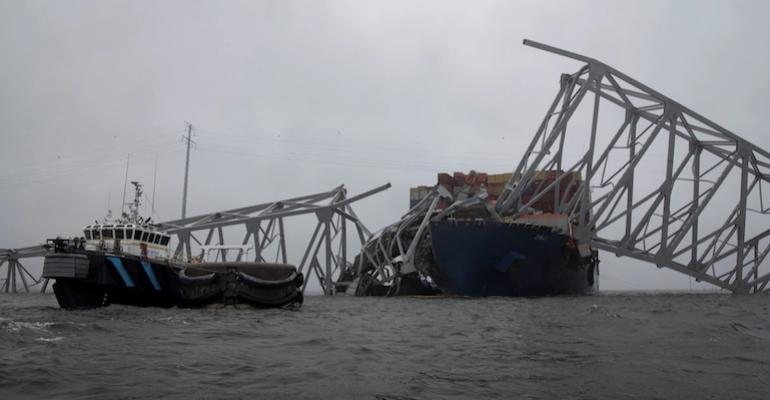Under the auspices of a “Unified Command” - spearheaded by the US Coast Guard, and including the US Army Corps of Engineers, the Maryland Department of the Environment, Maryland Transportation Authority, Maryland State Police, along with representatives Synergy Marine, debris is being removed. The removal efforts have been slowed down by storms with gale-force winds which pelted the US East throughout Wednesday, 3 April. The Unified Command has also released footage of the diving operations to assess damage to the Dali and determine where it is grounded.
With the blockage of the main channel, which had been dredged in spots to 50 feet, the old Sparrows Point facility, once a shipyard owned by now-defunct behemoth Bethlehem Steel, now repurposed as the Tradepoint Atlantic terminal, outside of the Key Bridge and therefore accessible to deepsea traffic, is taking up some of the slack. Besides providing laydown acreage for debris material, which eventually will be disposed, the terminal has set aside acreage for handling redirected cargo.
Two temporary channels traversing waters underneath intact portions of the bridge span have been opened for transit by tugs and barges. These channels are draft restricted and limited for daylight transits at the discretion of the Coast Guard Captain of the Port, and during daylight hours only. The first temporary channel has “a controlling depth of 11 feet, a 264-foot horizontal clearance, and vertical clearance of 95 feet.”
The first transit saw Dann Marine’s Crystal Coast, which had been unable to transit out of the port, pushing a fuel barge outbound. The Unified Command is working on a second channel, which will have a draft circa 15 – 16 feet.
It remains to be seen whether barge operators who had been prepping fleets for offshore wind applications might temporarily re-purpose their deck barges and similar for transit of containers and automobiles. Baltimore is a leading port for moves of automobiles, trucks and farm equipment) from the port’s main docks to Tradepoint Atlantic.
There are many bigger-picture questions. The National Transportation Safety Board (NTSB) is responsible for the investigation of the causes behind the power outages aboard Dali as it was approaching the bridge outbound, which led to the allision. While there are numerous theories - fuel-related issues, shipboard electrical systems, and even intimations of cyber-crime - the NTSB will methodically examine all the evidence.
The NTSB will also look closely at structural issues surrounding the Francis Scott Key bridge. These will include the viability of “truss” bridges, versus other types- such as suspension bridges, or lift bridge given the configuration of motorway traffic and vessel transits. Additionally, the placement of fenders or dolphins at the base of bridge supports will be a subject for the NTSB investigations; some experts have suggested that these measures might not have prevented the tragedy given the powerful force of the Dali allision.
Many commentators have noted that containerships have grown dramatically in size since the late 1970’s opening of the now downed Key Bridge, and better guidance may be needed.
Other issues sure to be discussed include the deployment of ship assist in channels; the commentators go in multiple directions here. While tugboats alongside Dali might have prevented the allision, others have suggested that narrow channels would limit the practicality of tug assist, and that tail tugs might not have been able to move into timely action.
As port experts note, “if you’ve seen one port, you’ve seen one port,” meaning that each port has unique circumstances; so we can expect much debate, rather than instant answers.
Copyright © 2024. All rights reserved. Seatrade, a trading name of Informa Markets (UK) Limited.
Add Seatrade Maritime News to your Google News feed.  |

